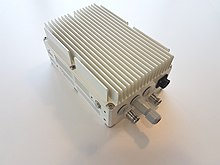Hello Experts.
What is the difference between ODU and RRU?


Hello Experts.
What is the difference between ODU and RRU?


The ODU - OutDoor Unit (or RAU - Radio Access Unit) is present in the Microwave system while the RRU is present in the Radio System.
ODU is connected to the satellite dish antenna while RRU - Radio Remote Unit access the antenna of the sector.
ODU is responsible for amplifying power and raising and lowering frequency. And it works at high frequencies, from 6 GHz to 86 GHz.
RRU works on 2G, 3G, 4G, 5G technology, and is responsible for power amplification and modulation, demodulation. It operates on frequencies like 800, 900, 1800, 1900, 2100, 2600 MHz.
Every microwave link is a point-to-point link, and each side of the link has an IDU (In Door Unit) and ODU (Out Door Unit).
A remote radio head (RRH), also called a remote radio unit (RRU) in wireless networks, is a remote radio transceiver that connects to an operator radio control panel via electrical or wireless interface . When used to describe aircraft radio cockpit radio systems, the control panel is often called the radio head.
Source: Remote radio head - Wikipedia

Microwave ODU ( Outdoor Unit )
The term ODU is used in Split-Mount Microwave systems where an Indoor Unit (IDU) is typically mounted in an indoor location (or weatherproof shelter) connected via a coaxial cable to the ODU which is mounted on a rooftop or tower top location.
Source: Microwave ODU - Microwave Link

The ODU is contains the actual modem that modulates the E1, E3 or STM-1 link onto the IF (Intermediate Frequency)
which is put on the coaxial link towards the ODU.
Conversely, on a different IF, there is the down-link from the ODU towards the demodulator/decoder in the IDU.
In the Mini-Link system, the ODU is commonly called RAU (Radio Access Unit).
ODU for Transport (Microwave) and RRU for Radio (BTS) 2G3G4G or 5G.
RU: the radio unit
RF TRANSMITTER
In a 5G RAN architecture, the BBU functionality is split into two functional units:
DU: this is the distributed unit, a logical function (software)
REAL-TIME PROCESSING
CU: this is the centralized unit (software)
NON REAL-TIME PROCESSING